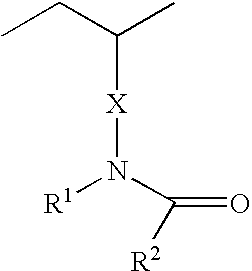Solutions for ophthalmic lenses containing at least one silicone containing component
a technology of silicone and ophthalmic lenses, which is applied in the direction of instruments, non-metal conductors, conductors, etc., can solve the problems of adding cost and complexity to the lens manufacturing process in the surface treatment process
- Summary
- Abstract
- Description
- Claims
- Application Information
AI Technical Summary
Benefits of technology
Problems solved by technology
Method used
Image
Examples
example 1
[0044]100 parts of the components shown in Table 2 and, in the amounts shown in Table 2 were mixed with 23 parts 3,7-dimethyl-3-octanol (D3O) to form a reaction mixture. The reaction mixture was mixed vigorously (or until the solution appeared clear and evenly mixed) and then degassed, on high vacuum.
TABLE 2ComponentWeight PerCentNorbloc2.00CGI 18500.48mPDMS 100031.00DMA24.00HEMA6.00TEGDMA1.50SiMAA228.00Blue HEMA0.02K907.00
[0045]The reaction mixture was then placed into thermoplastic contact lens molds and irradiated using fluorescent bulbs (intensity of about 1 mW / cm2 for 8 minutes and about 4 mW / cm2 for 4 minutes) at 45° C. under a nitrogen atmosphere. After curing, the molds were opened, the lenses were demolded and hydrated as follows 70 / 30 IPA:DI water for 60 min, 100% IPA for 60 min, 70 / 30 IPA:DI water for 60 min, 10 / 90 IPA:DI water for 30 min and equilibrate in DI water. The hydrated lenses were stored in jars containing DI-water with 50 ppm of methylcellulose.
examples 2-6
[0046]To a borate buffer solution (0.185 wt % sodium borate, 0.926% boric acid and 0.005 wt % methyl cellulose) sodium chloride was added in varying amounts, as shown in Table 3, below. The osmolality and conductivity for each solution is also listed. Lenses made in Examples 1 were placed in the solutions listed in Table 3, below. The lenses were autoclaved once in the respective packaging solutions. Lenses were removed from the package and immediately applied to each subject's eye. The lenses were intentionally not rinsed prior to insertion.
[0047]Subjects wore the lenses for approximately 30 minutes prior to lens evaluation. Lenses were then removed using standard clinical techniques.
[0048]After lenses were removed, corneal epithelial integrity was evaluated using fluorescein sodium dye. Fluorescein sodium dye strips were moistened using a couple of drops of non-preserved saline and the strip was lightly dabbed on the bulbar conjunctiva of each eye. After a brief period (5-10 secon...
examples 7-10
[0050]Examples 2-6 were repeated except that sodium sulfate was used instead of sodium chloride. The results are shown in Table 4, below.
TABLE 4ConductivityOsmolaltiy#%Ex. #[Cl−] wt %(mS / cm)(mOsm / kg)eyesstaining700.7163610080.375.1223103090.486.4245100101.415.338260
PUM
| Property | Measurement | Unit |
|---|---|---|
| osmolality | aaaaa | aaaaa |
| osmolality | aaaaa | aaaaa |
| conductivity | aaaaa | aaaaa |
Abstract
Description
Claims
Application Information
 Login to View More
Login to View More - R&D
- Intellectual Property
- Life Sciences
- Materials
- Tech Scout
- Unparalleled Data Quality
- Higher Quality Content
- 60% Fewer Hallucinations
Browse by: Latest US Patents, China's latest patents, Technical Efficacy Thesaurus, Application Domain, Technology Topic, Popular Technical Reports.
© 2025 PatSnap. All rights reserved.Legal|Privacy policy|Modern Slavery Act Transparency Statement|Sitemap|About US| Contact US: help@patsnap.com


